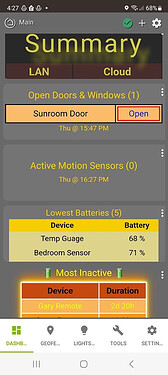Is there a matrix somewhere that compares the attributes of the alternatives to the native HE dashboard? If so can someone post a link?
I really prefer to stay with native HE apps whenever possible, but the dashboard just looks so bad. Since others are charging I wish HE would just charge for a better native dashboard that I can be assured will continue working. Alternatively, is there a link to tips and tricks to make the native dashboard look better without Custom (third party non native) apps?
The attributes I'm interested in, in order of priority are:
- Privacy - ie everything is local and my data is not on or going through someone else's server
- Remote access - I don't understand how this works with the native HE dashboard. Am I going through HE's servers to access the dashboards when I am not on my home's wifi network? Or is my phone somehow connecting direct to my local HE device through internet magic?
- Stability - with any 3rd party app, I'm concerned it will stop being supported, and then HE will upgrade and that will break it. I REALLY don't want to deal with that.
ETA 3.5: Ability to display graphs - Cost
- UI and results
- Other?
Poking around this forum, I think (not sure) these are my options:
Smartly or Smartly Inject (not sure about the difference):
Local but they might harvest data (they are a business and I really don't understand their website - seems like a HE competitor and I've already bought an HE so don't need a new OS), not sure about remote access, 3rd party, free, supposedly better looking dashboard with limitations but their website is terrible so don't have much confidence there
Hubivue
Local, not sure about remote access, 3rd party, free for up to 10 dashboards with 50 tiles each and limited themes, icon and access; $30/year to remove the limitations, better looking
Tile Builder
Local, not sure about remote access, 3rd party, free, MUCH better use of screen real estate
ActionTiles
Not local, has remote access, 3rd party, current free for HE due to beta but $30 one time fee after they go commercial? (website does not even mention HE so confusing), similar look to HE native dashboard so not understanding the advantage other than remote access.
Other confusing options with high barriers to entry for those who are not programmers and hardware experts, such as Influx, node red, HA integration, grafana, etc
Other?




